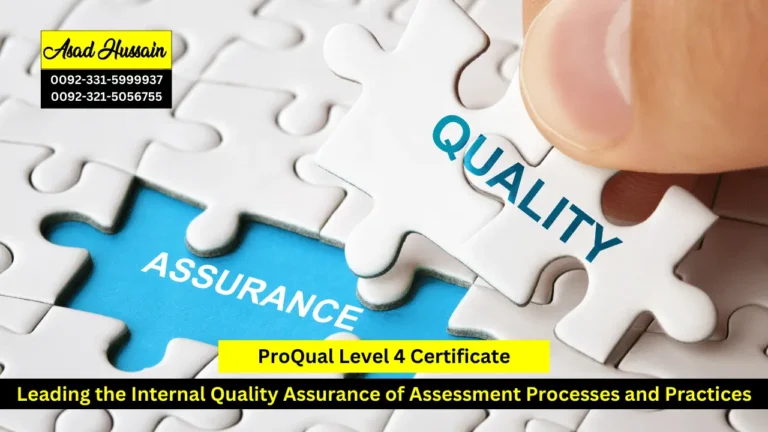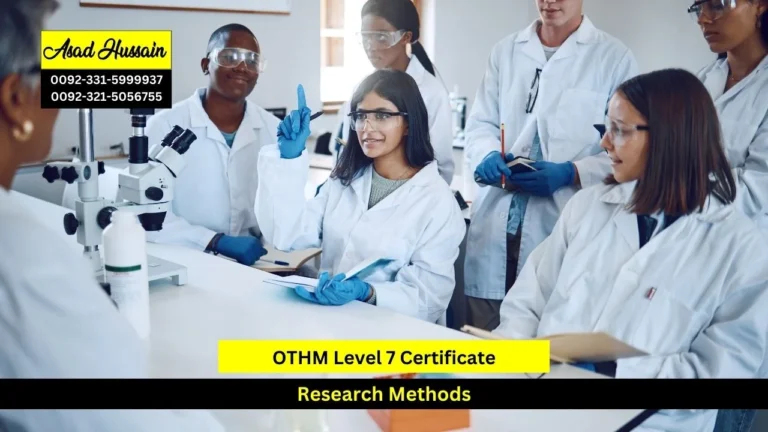The OTHM Level 3 Technical Certificate in Occupational Health and Safety is designed to provide learners with a strong foundation in health and safety principles, helping them understand the key concepts, regulations, and risk management strategies that contribute to a safer workplace. This qualification focuses on providing practical knowledge and skills that can be applied directly to real-world work environments.
The OTHM Level 3 Technical Certificate in Occupational Health and Safety is designed to cover a broad range of topics within occupational health and safety. It introduces learners to the basic principles of risk assessment, accident investigation, and safety management, while also focusing on the key legislation and regulations that guide safety practices in the workplace.
This Ofqual-regulated qualification ensures that the course is recognized by employers and academic institutions worldwide, providing learners with a credible and respected certification. The course is assignment-based, offering flexibility to study at your own pace while applying the knowledge gained directly to your role in occupational health and safety.
The OTHM Level 3 Technical Certificate in Occupational Health and Safety is an excellent qualification for individuals seeking to enhance their knowledge of health and safety practices in the workplace. Whether you’re just beginning your career in health and safety or want to formalize your existing experience, this Ofqual-regulated qualification offers the knowledge, skills, and practical application to succeed in the field.
Program Highlights
Study Units
Principles of Occupational Health and Safety
- Overview of the role of health and safety in the workplace
- Importance of effective health and safety management systems
- Basic principles of risk assessment and control
- Legal and organizational frameworks for health and safety
Risk Assessment and Management
- Introduction to risk assessment techniques and processes
- Identification of hazards in the workplace
- Evaluation of risk severity and likelihood
- Methods of risk control and mitigation strategies
- Use of risk assessment tools
Health and Safety Legislation
- Understanding of health and safety laws and regulations
- Key legislation related to workplace safety (e.g., Health and Safety at Work Act, regulations, and standards)
- Legal obligations of employers and employees
- Role of regulatory bodies in enforcing safety standards
Accident Investigation and Reporting
- Procedures for accident investigation and root cause analysis
- Methods for collecting evidence and data during investigations
- Creating reports and documenting findings
- Developing corrective and preventive actions to avoid future incidents
Control of Workplace Hazards
- Identification and classification of workplace hazards (e.g., physical, chemical, ergonomic, psychosocial)
- Control measures for each type of hazard
- Techniques for implementing hazard controls (engineering controls, administrative controls, and personal protective equipment)
- Safety management systems and how to implement them effectively
Emergency Procedures and First Aid
- Understanding emergency procedures in the workplace
- Developing and implementing emergency response plans
- Fire safety and evacuation procedures
- First aid procedures and their application in emergency situations
- The role of emergency responders and the importance of communication in emergencies
To enroll in the OTHM Level 3 Technical Certificate in Occupational Health and Safety, applicants must meet the following entry requirements:
- Age Requirement: Applicants must be at least 18 years of age.
- Educational Qualifications:
- A minimum of GCSEs or equivalent qualifications (ideally including English and Mathematics).
- Applicants should have a basic understanding of health and safety principles or relevant work experience.
- English Language Proficiency:
- Applicants should have a good command of the English language, as the course content and assignments will be delivered in English. Non-native English speakers may need to provide proof of English language proficiency (e.g., an IELTS score of 5.5 or equivalent).
- Work Experience (Optional but Beneficial):
- While not mandatory, some experience or knowledge of working in environments where health and safety practices are implemented can be helpful in understanding the course content and its real-world applications.
- Computer and Internet Access:
- Since the course is assignment-based, learners will need access to a computer with an internet connection to complete and submit coursework.
- Personal Motivation and Commitment:
- Applicants should be motivated to pursue a career in health and safety and be committed to completing the course and assignments within the stipulated timeframe.
Upon successful completion of the OTHM Level 3 Technical Certificate in Occupational Health and Safety, learners will be able to:
1. Principles of Occupational Health and Safety
- Understand the role of health and safety in the workplace and its importance in safeguarding employees and ensuring legal compliance.
- Appreciate the need for effective health and safety management systems in reducing workplace hazards and preventing accidents.
- Demonstrate the basic principles of risk assessment and control, identifying risks and implementing measures to mitigate them.
- Understand the legal and organizational frameworks that underpin health and safety practices, ensuring adherence to regulations and industry standards.
2. Risk Assessment and Management
- Apply risk assessment techniques to identify hazards and evaluate the severity and likelihood of potential risks in the workplace.
- Demonstrate the ability to assess risks and implement effective control measures to reduce or eliminate those risks.
- Use risk assessment tools and methods to conduct thorough analyses, ensuring a systematic approach to identifying and controlling hazards.
- Understand and implement risk management strategies, applying appropriate measures to ensure safety and minimize risk exposure.
3. Health and Safety Legislation
- Understand health and safety laws and regulations that govern workplace safety, including the Health and Safety at Work Act and other relevant legislation.
- Identify key legislation and regulations related to workplace safety, and ensure compliance with both national and international safety standards.
- Understand the legal obligations of both employers and employees in maintaining a safe working environment.
- Recognize the role of regulatory bodies in enforcing safety standards and ensuring legal compliance.
4. Accident Investigation and Reporting
- Conduct accident investigations, identifying the root causes of workplace incidents, accidents, or near misses.
- Apply appropriate methods for collecting evidence and documenting findings during investigations.
- Develop and recommend corrective and preventive actions based on investigation outcomes to prevent similar incidents from occurring in the future.
- Create accident and safety reports that accurately document findings, actions taken, and lessons learned.
5. Control of Workplace Hazards
- Identify and classify workplace hazards, including physical, chemical, ergonomic, and psychosocial risks.
- Implement appropriate control measures for each type of hazard, ensuring a comprehensive approach to workplace safety.
- Apply techniques for controlling hazards, including engineering controls, administrative controls, and personal protective equipment (PPE).
- Understand and apply safety management systems to ensure effective implementation of hazard control measures and continuous safety improvement.
6. Emergency Procedures and First Aid
- Develop, implement, and evaluate emergency procedures for various workplace emergencies, including fires, medical emergencies, and evacuations.
- Demonstrate knowledge of fire safety, evacuation procedures, and first aid techniques to manage emergency situations effectively.
- Understand the role and responsibilities of emergency responders, including the importance of effective communication during emergencies.
- Provide basic first aid to injured individuals, responding appropriately in line with emergency protocols.
Aspiring Health and Safety Professionals
- Individuals who want to pursue a career in health and safety and gain foundational knowledge and skills to work in the field.
Managers and Supervisors
- Managers, supervisors, and team leaders responsible for the health and safety of their teams or departments, seeking to enhance their ability to manage and mitigate risks in the workplace.
HSE (Health, Safety, and Environmental) Officers
- HSE officers and professionals who are already working in health and safety roles and want to strengthen their understanding of safety management systems, risk assessments, and accident investigation.
Business Owners and Employers
- Business owners or employers who need to understand essential health and safety principles and ensure their organization complies with health and safety regulations and standards.
Construction, Manufacturing, and Industrial Workers
- Workers or professionals in high-risk industries like construction, manufacturing, or engineering, where workplace health and safety is critical and formal knowledge of risk control and accident prevention is required.
Individuals Transitioning into the Health and Safety Sector
- Professionals transitioning into a health and safety career from other fields (e.g., HR, operations, or quality management) who wish to gain a recognized qualification.
Employees Working in High-Risk Environments
- Individuals working in sectors like transport, logistics, warehousing, or oil and gas, where safety is critical and knowledge of emergency response, risk assessment, and hazard control is necessary.
Individuals Seeking Career Progression
- Professionals in health and safety support roles seeking career advancement opportunities or wishing to specialize in areas like safety audits, compliance, or incident management.







